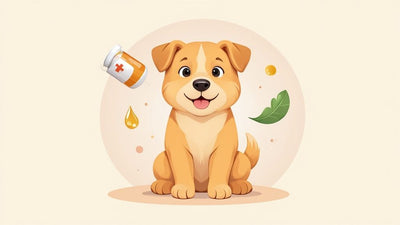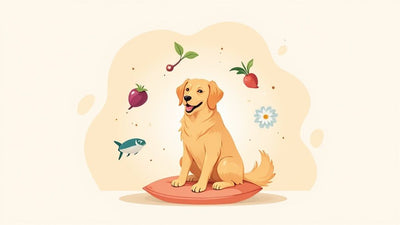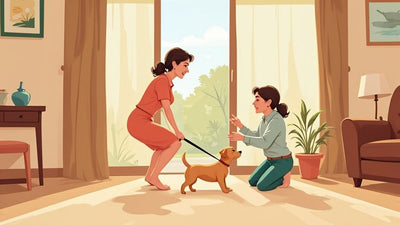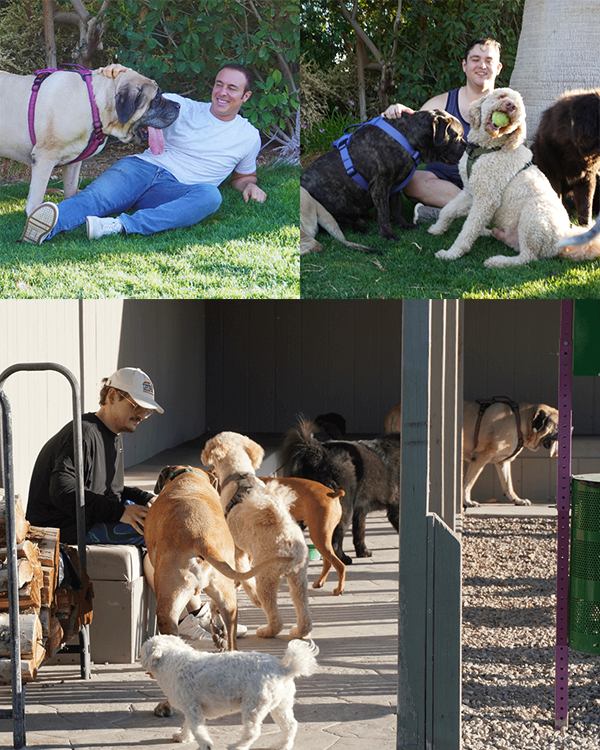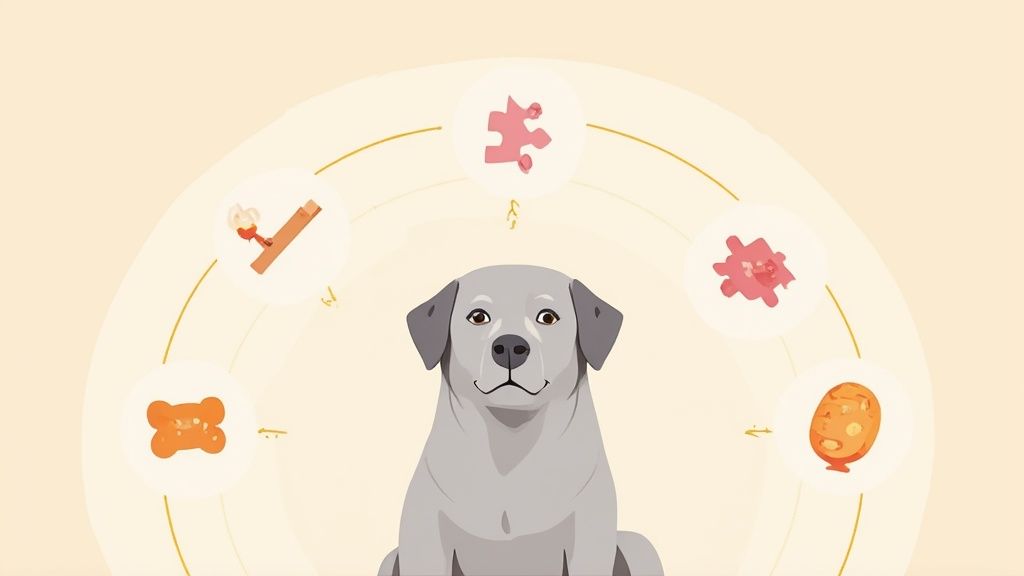
Navigating the Gentle Shifts in Your Aging Dog's Behavior
You're not imagining it. Maybe your dog stood at their water bowl, confused about why they were there. Or perhaps they got a little lost on a walk you've taken together a thousand times. These aren't just quirks; they are quiet signals that your dog's world is changing, and they're asking for your help on this new journey.
Recognizing the First Signs: When Your Dog's World Changes
The changes often creep in so quietly you might second-guess yourself. You might see your dog standing by the back door, forgetting they just asked to go out. Or you've been woken up by the soft patter of paws pacing the hallway when they used to sleep soundly. We understand. These are some of the most common early aging dog behavior changes, and you're not alone in noticing them.
If you’ve found yourself doing one of those 3 AM internet searches for "why is my old dog confused," you're in good company. It's a journey many of us take with our beloved companions. These shifts aren't a sign you've done anything wrong—they're a natural part of aging for so many dogs. The first step to providing comfort is simply understanding what's happening.
Common Early Behavioral Signals
Every dog's journey is unique, of course, but certain patterns tend to show up as they get older. Recognizing them early means you can step in with gentle support that much sooner. Think of these as little flags your dog is waving to get your attention.
Here are a few common signals to watch for:
- New Confusion or Anxiety: This can look like your dog getting stuck behind a chair, staring blankly at a wall, or seeming disoriented in your own home.
- Changes in Sleep: It's very common for senior dogs to have their sleep cycles flip. They might be restless and wandering at night, only to sleep more deeply during the day.
- Shifting Social Interactions: A dog who once loved visitors might suddenly become withdrawn. On the other hand, some develop new separation anxiety and can't bear to let you out of their sight.
- Forgetting Familiar Routines: When a dog who has known "sit" for a decade just stares at you blankly, it's rarely defiance. More often, it's genuine forgetfulness.
We understand how tough it is watching your best friend forget their favorite toy or seem anxious for no clear reason. On this path, small improvements—like a peaceful night's sleep or a moment of happy recognition—are worth celebrating.
New anxieties can be especially complex. If you want to dig deeper into what might be causing these feelings in your dog, you can learn more about canine anxiety and behavior in our detailed guide.
To help you sort through what you might be seeing, here’s a quick-glance table. It’s designed to help you identify common behaviors and think about the potential reasons behind them in a simple, non-alarming way.
Common Aging Behavior Changes and What They Might Mean
| Observed Behavior | What It Could Mean | A Gentle Way to Think About It |
|---|---|---|
| Pacing or wandering at night | Disrupted sleep-wake cycles, anxiety, or discomfort. | Their internal clock might be a little off, just like ours can get. |
| Staring at walls or corners | Cognitive changes (Canine Cognitive Dysfunction), vision issues. | They might be having a moment of confusion, like when we walk into a room and forget why. |
| Increased clinginess or separation anxiety | A need for more reassurance, confusion, or hearing/vision loss. | The world feels a bit uncertain, and you're their safe space. |
| Forgetting commands or house-training | Memory loss associated with aging, potential hearing loss. | Their mental filing cabinet is getting a bit disorganized. |
| Less interaction with family or other pets | Physical discomfort (like arthritis), hearing loss, or general fatigue. | They might just not have the social energy they used to, or they could be a bit sore. |
Seeing these signs is the first step. The next is learning how to respond with patience, comfort, and love.
What These Changes Really Mean
It's completely natural to feel a pang of worry when you notice these shifts. But it can be helpful to reframe what you're seeing. Instead of viewing them as "problems," try to see them as a new form of communication. Your dog isn't trying to be difficult; they're simply trying to navigate a new internal world. When they forget the familiar route home from the park, it just means the mental map they've always used is getting a little fuzzy.
This is a journey you're on together. By tuning into these gentle nudges, you become their most important advocate, ready to offer the comfort they need to maintain their quality of life. The goal isn't to turn back the clock, but to fill their days with as much comfort, clarity, and connection as possible.
Get Your FREE Dog Brain Health Guide

Get instant FREE access to today's top ways to help your best friend live a longer, healthier, happier life.
- 39 value-packed pages of expert insights
- Early-detection tips for cognitive decline
- Top brain-boosting superfoods
- Vet-approved mental sharpness strategies
- Fun IQ tests for your dog
The Gentle Science Behind Your Senior Dog's New Behaviors
Watching your loyal companion stand confused in a room they've known for years can be heartbreaking. We see you. It’s a moment that sparks more than just concern; it brings a wave of worry. But understanding the gentle science behind these shifts can turn that anxiety into calm, confident action.
The new habits you're seeing aren't random. They almost always trace back to one of two places: changes happening inside their brain or discomfort coming from their body. Recognizing this dual possibility is the first step to giving them the right kind of support.
Two Paths: Cognitive Changes and Physical Discomfort
Imagine your dog’s mind is a familiar trail they've walked every day of their life. As they get older, that path can start to get a little overgrown, making it harder to navigate. This is a simple way of thinking about cognitive changes.
At the same time, their body is starting to feel the mileage from years of joyful running and playing. Their joints can get stiff and sore. This physical discomfort can have a huge impact on their mood and how much they want to interact with the world.
This infographic gives a great visual of how these internal changes can show up in your dog’s everyday life.
What might just look like a tired pup napping more can actually be a window into these deeper changes, reminding us to approach them with extra patience and care.
The Overgrown Path: Understanding Canine Cognitive Dysfunction
One of the biggest reasons behind aging dog behavior changes is a condition called Canine Cognitive Dysfunction, or CCD. Think of it as age-related brain fog. If you're seeing signs like disorientation or forgetting old routines, you're not alone—it's a very real part of the aging journey for countless dogs.
In fact, research shows CCD affects about 28% of dogs between 11 and 12 years old. That number jumps to 68% in dogs aged 15 to 16. The classic signs are things like disorientation, forgetting old routines, a mixed-up sleep schedule, and sometimes being more irritable.
So, when your dog stares blankly at the hinge side of a door, it's not them being stubborn. It’s a moment where that familiar path in their mind has become temporarily blocked. They know they want to go out, but the 'how' part has suddenly become confusing.
It's helpful to remember that your dog isn't giving you a hard time; they're having a hard time. This shift in perspective is the first step toward compassionate support.
Supporting them through this often means sticking to routines, making their environment safer, and providing nutritional support to help maintain brain health. To dive deeper, you might find our guide on understanding cognitive decline in dogs helpful.
When the Body Speaks Through Behavior
But what if it's not about brain fog? Sometimes, a behavioral shift has nothing to do with cognition and everything to do with physical discomfort. A dog who suddenly gets grumpy or growls when you try to pet them isn’t necessarily turning aggressive—they might just hurt.
Think about these common scenarios:
- Hesitation at the stairs: This is a classic early sign of joint discomfort. Every step can be a challenge, making them reluctant to climb stairs they once bounded up without a second thought.
- Reluctance to be touched: If a certain spot on their body is sore, even a gentle pat can be uncomfortable. This is easily mistaken for a personality change when it’s really just a cry for "ouch!"
- Increased irritability: Wouldn't you be a bit cranky if you were in constant, low-grade discomfort? A dog who is always a little sore will naturally have less patience for a noisy house or a bouncy puppy.
These physical issues can even make cognitive symptoms seem worse. A dog in discomfort doesn't sleep well, and a lack of sleep can lead to more confusion and anxiety. It can quickly become a cycle where physical aches and mental fog feed off each other.
By gently asking yourself—is this a moment of confusion, or a sign of discomfort?—you become a better detective for your dog's needs. This dual perspective is your most powerful tool, empowering you to offer targeted support that truly makes a difference. The goal isn't a miracle cure; it's about providing comfort and creating more good days together.
How Your Dog's Size Shapes Their Aging Journey
As you watch your dog enter their golden years, it's totally normal to wonder when you might start seeing those first, subtle changes in their behavior. It’s one of the great ironies in the dog world: the bigger the dog, the shorter the lifespan.
This accelerated aging means that larger breeds often start showing signs of being a senior a bit sooner than their pint-sized pals. So no, you're not imagining things if your seven-year-old Great Dane seems to have more "old soul" moments than your neighbor's ten-year-old Chihuahua.
This isn't meant to be alarming. Instead, think of it as a roadmap for what to expect. Knowing this helps you tune into your dog's unique needs and honor the journey they're on.
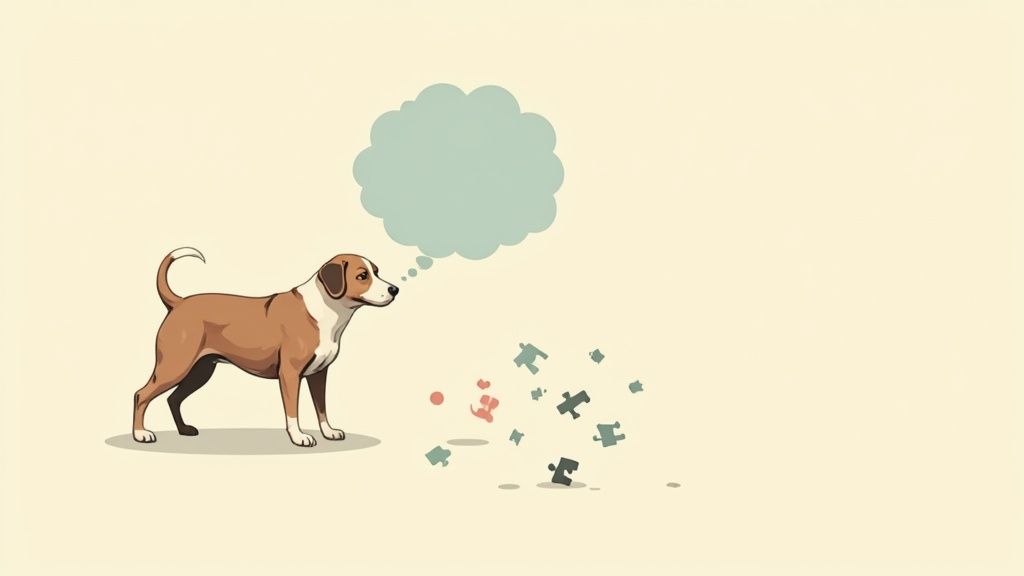
The Link Between Body Size and Brain Health
The connection between a dog's size and how they age is more complex than you might think. It’s not just about when the changes begin, but also about the pace at which they unfold.
Recent research has started to unravel this mystery. Studies show that dogs weighing over 30 kilograms (that’s about 66 pounds) tend to show signs of behavioral changes roughly two to three years earlier than smaller dogs. This is likely tied directly to their faster physical aging process. If you’re curious, you can discover more about the research on aging in different dog sizes to see the science behind it.
What does this mean for you? You might catch your senior German Shepherd staring blankly at a wall a few years before a smaller dog of the same age would do the same.
A Slower Pace for Gentle Giants
But here’s where the story takes a more comforting turn. While large dogs might start down the path of cognitive change earlier, that same research reveals a hopeful twist: the changes are often slower for them.
This is a really important piece of the puzzle. It suggests that those initial signs aren't necessarily a sign of rapid decline. Instead, they’re a gentle nudge to start providing support a little sooner. Small tweaks to their diet, routine, and environment can make a world of difference in helping maintain their clarity and comfort.
The goal isn't to stop the clock, but to make the time that's left as full of connection and good days as we can. Understanding your dog's specific timeline helps you do just that.
At the end of the day, every dog is an individual. Whether you share your life with a gentle giant, a tiny companion, or someone in between, your attention and love are what matter most. By understanding how their size plays a role, you’re simply better prepared to give them the compassionate, proactive support they deserve.
How a Senior Dog's Activity and Alertness Changes
It's a familiar sight for any of us with a gray-muzzled friend: the dog who once lived for fetch now seems to prefer a long nap in a sunbeam. This shift is one of the most obvious signs of aging, but it's not the whole picture. While their body might be slowing down, their mind is often still ready and waiting to connect with you.
We tend to lump physical and mental changes together, assuming that a slower body must mean a slower mind. But that's rarely how it works. The truth is, an aging dog's cognitive journey is full of nuance, and many seniors keep their sharp wit and problem-solving skills long after their running days are behind them.
This is such a hopeful reality. When we understand that their mind can stay bright, we can find new, gentler ways to engage with them and celebrate the clever companion who is still very much there.
The Spark That Stays Lit
It might surprise you to learn that a dog's mental abilities don't all fade at the same pace. Some skills, in fact, stay remarkably strong well into their golden years. That intelligent, curious personality you've known for so long is still present, just communicating its needs in a slightly different way.
Research backs this up. Studies have found that while a dog's problem-solving skills and attentiveness grow throughout their youth, they often show only a minor decline in old age. The changes are gradual and specific, not a total shutdown. In fact, many older dogs become less distracted by new things, showing more focused behavioral control. If you want to dive into the science, you can read the full study on these cognitive findings here.
So, what does this actually look like at home?
- Focused Problem-Solving: Your senior dog might still be a genius at figuring out a simple puzzle toy, even if they can't chase a ball for an hour.
- Keen Observation: They're often still incredibly tuned into your life. They know the sound of the treat jar opening from two rooms away and can read your mood like a book.
- Strong Social Bonds: Their need for connection doesn't fade. They still rely on you for comfort and are masters at reading the social cues of the entire family.
Adapting Play for a Slower Pace
Because that mental spark is still burning brightly, enrichment is just as important as it was in puppyhood—it just needs a makeover. The goal is no longer about high-impact exercise; it’s about gentle mental workouts that keep their brain healthy and engaged. It's about meeting them where they are now, not dwelling on what they used to do.
Success looks different with a senior. It's measured in peaceful nights and moments of clear recognition. A senior dog methodically nudging a puzzle toy to get a treat is a massive win, reminding us that a clever mind is still hard at work.
Instead of a frantic game of fetch, think about brain games that are low-impact but high-reward:
- Scent Work: A dog's sense of smell is powerful and often one of the last senses to fade. Hide a few smelly treats around a room and let them use their nose to find them. It's incredibly satisfying for them.
- Simple Puzzle Toys: Look for beginner-level food puzzles that they can solve with a nudge of their nose or a gentle paw, without needing a lot of physical force.
- Gentle Training: Run through some of the basic commands they've known for years. The mental effort and positive reinforcement are fantastic for their cognitive health.
By celebrating their enduring alertness and finding new ways to challenge their mind, you're supporting their well-being in a profound way. It’s a beautiful way to honor the intelligent spirit that has made your bond so special for all these years.

Support Your Dog's Brain Health with NeuroChew™
As mentioned in this article, NeuroChew is the first dog chew designed to support both cognitive function and healthy circulation. Perfect for dogs showing early signs of cognitive decline or for proactive brain health support.
Practical Ways to Support Your Aging Dog's Mind and Body
Watching your dog age is a journey, and understanding the changes they're going through is the first, most important step. The good news? There are so many small, gentle ways you can support them, making this chapter of their life as comfortable and happy as possible.
This isn't about "fixing" old age; it's about making their world a little easier to navigate, both physically and mentally. A few thoughtful adjustments can lead to more peaceful nights, less confusion, and more of those sweet moments of connection you both cherish.
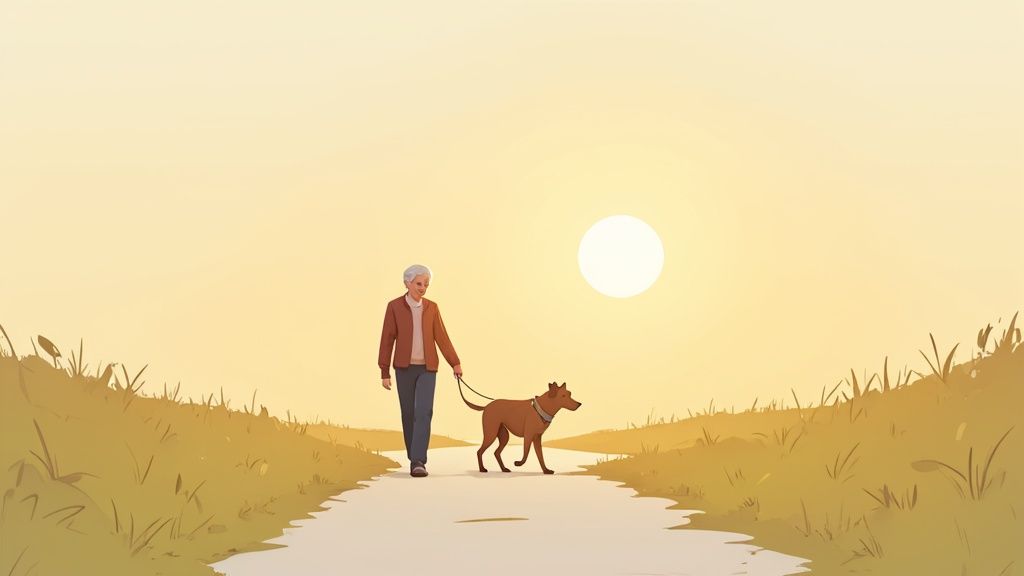
Creating a Safe and Comfortable Environment
As your dog’s senses and mobility change, the home they’ve known forever can suddenly feel like an obstacle course. Your job is to become their loving safety manager, spotting potential problems before they cause stress. The goal is simple: make their environment predictable and secure to support their confidence.
A few easy tweaks can make a world of difference:
- Improve Traction: Slick floors can be scary for an older dog. Lay down non-slip rugs or runners on hardwood and tile. This gives them the footing they need to walk confidently, which is a game-changer for dogs with stiff joints.
- Light the Way: A disoriented dog in the dark is an anxious dog. Plug in a few nightlights in hallways, near their bed, and by their water bowl. It’s a simple fix that can dramatically reduce nighttime pacing and anxiety.
- Create Clear Pathways: Predictability is comfort. Try to keep furniture in the same spot and make sure walkways are always clear of clutter. For a dog with fading eyesight or cognitive fog, knowing their route is incredibly reassuring.
When a dog feels safe in their space, they can truly relax. This conserves their energy for the good stuff—like enjoying your company.
Nurturing Their Mind with Gentle Enrichment
Their body might be slowing down, but their mind still craves connection and gentle engagement. Mental enrichment is one of the best tools for maintaining cognitive function and strengthening your bond. We're not talking about strenuous training; we're talking about simple, rewarding challenges.
Think of it as light exercise for their brain, keeping those neural pathways firing.
You're not alone in navigating this. We measure success in small wins—like when your dog solves a simple puzzle for the first time in months, or when they sleep peacefully through the night again. These moments matter most.
Here are a few ideas for low-impact mental fun:
- Scent Games: A dog’s nose is their superpower, even in old age. Hide a few smelly, high-value treats in a snuffle mat or around a room and let them "find it." This taps into their natural instincts and is deeply satisfying.
- Simple Food Puzzles: Look for puzzle toys that only require gentle nudging or licking, not vigorous shaking. A lick mat smeared with a little dog-safe peanut butter or yogurt provides a calming, focused activity that can last a surprising amount of time.
- Short, Positive Training Sessions: Dust off the old commands they’ve known for years. The simple act of thinking, responding, and earning your praise is a fantastic mental workout that reinforces your special connection.
These little activities give them a sense of purpose and accomplishment, which is so important for their emotional well-being.
The Power of Nutritional Support for Brain Health
Just as we might change our own diets as we get older, targeted nutritional support can be one of the most powerful things you do for your senior dog. The right nutrients help maintain brain health and promote mental clarity. You're essentially giving their brain the fuel it needs to function at its best.
Think of it like tending a garden. For plants to thrive, they need good soil, water, and the right food. It’s the same with your dog’s brain. Ingredients like Phosphatidylserine are a cornerstone here, providing crucial "brain cell support" by helping to maintain the structure of those delicate brain cells.
Healthy circulation is another key piece of the puzzle. Good blood flow is what delivers all that vital oxygen and nutrition to the brain. Ingredients like Beet Root Powder can gently support this process, helping ensure the brain gets everything it needs for clear thinking.
This is where a thoughtfully crafted supplement can make a real difference. By combining ingredients that support both brain cell health and circulation, you’re tackling cognitive wellness from two critical angles. For a deeper look, our guide on approaches to Canine Cognitive Dysfunction offers more detailed insights.
While every dog's journey is unique and results may vary, providing this foundational nutritional support gives them their best shot at having more good days. It’s a proactive, loving step you can take together, every single day.
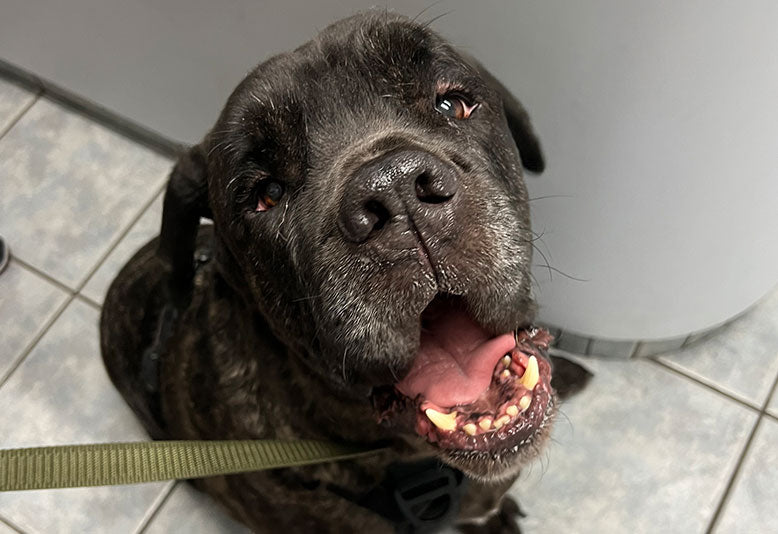
Real Results: How NeuroChew Helped Brutus Regain His Mental Clarity
Brutus was getting disoriented at night. After starting NeuroChew, he's more happy during the day and steady at night. He's back to his old self!
Cherishing Your Journey Together Through Their Golden Years
Watching your dog enter their golden years can be a bittersweet experience, full of questions and worry. It’s easy to feel overwhelmed by the aging dog behavior changes you're seeing. But this chapter is a profound opportunity to deepen the incredible bond you've built over a lifetime. Your dog gave you their best, most vibrant years—now, you get to give them yours, filled with patience, understanding, and unwavering love.
This part of your journey together isn't about long hikes or frantic games of fetch anymore. The focus shifts to the quiet, meaningful connections that have always been the foundation of your relationship. It’s about celebrating the small wins—the ones that might not look like much to anyone else but mean the world to you and your old friend.
Redefining Success in the Golden Years
Success with a senior dog looks different. It’s no longer a perfect "sit-stay" at a busy park or a flawless recall. Now, it's measured in moments of comfort, clarity, and peace.
A huge win is a night where your dog sleeps soundly without pacing. It’s the soft wag of their tail when you walk into the room, a clear sign they recognize and are happy to see you. It's seeing them show a spark of interest in a toy they haven't touched in months. These are the new milestones, and they are beautiful.
Remember, you are the world’s foremost expert on your dog. You know their history, every little quirk, and the subtle shifts in their body language better than anyone. Your intuition, your gentle touch, and the familiar sound of your voice are the most powerful tools you have to support them.
"Your dog gave you their best years—now you can give them yours. We measure success in peaceful nights and moments of recognition."
When you look at it this way, the experience transforms. It's less about loss and more about a profound partnership. You are their advocate, their safe harbor, and the one constant they can rely on as their world becomes a little less predictable.
Focusing on More Good Days Together
It's natural to get caught up in what has changed, but the real magic is in cherishing what remains. Every single day you have together is a gift. The goal isn't to find a miracle cure or to turn back the clock. It’s much simpler and more powerful: it's to create more good days.
What does a "good day" look like? It might be a short, slow sniff around the block where they seem genuinely engaged with the world. It could be an afternoon napping side-by-side in a warm patch of sun. Or it might be the moment their eyes light up with accomplishment after solving a simple puzzle toy. These small improvements are everything.
Your journey through their senior years is a testament to the love you share. Think of it as a quiet, beautiful dance of mutual support. You provide the comfort and security they need, and they continue to offer the unconditional love that has enriched your life for so long. Every gentle pat, every soft word, and every shared moment is a celebration of a life well-lived and a bond that only grows stronger with time.
Common Questions About Senior Dog Behavior
It's completely normal to have a million questions when you're caring for an aging dog. Those late-night worries about your dog's new habits come from a place of love, and you deserve clear, gentle answers. We've put together some of the most common concerns we hear from families just like yours.
Why Is My Senior Dog Suddenly So Anxious at Night?
If you've found yourself pacing the halls with your dog at 2 AM, you're not alone. This is one of the most frequent changes people see. Nighttime anxiety—that classic pacing, whining, or restlessness—often ties back to a few key things.
One major reason is Canine Cognitive Dysfunction (CCD), which can disrupt their internal body clock. Just like with sundowning in humans, the quiet and dark can become a source of confusion and agitation. Fading senses also play a big part; when a dog can't see or hear as well, the world gets a little spookier after sundown. Simple things like a well-placed nightlight or a predictable evening wind-down routine can go a long way in helping them feel more secure.
Can These Behavior Changes Be Reversed?
This is a tough question, and it comes from a place of deep hope. When we talk about age-related changes, words like "cure" or "reverse" aren't realistic. But that doesn't mean we're helpless. Our goal shifts to support and management. We want to help maintain cognitive function and keep their minds as clear as possible for as long as possible.
Think of it less like turning back time and more like giving their brain the best possible tools to work with right now. With consistent, targeted support, many families notice real, meaningful progress—maybe it's a calmer night's sleep, fewer moments of confusion, or more flashes of their old, happy self.
We know you're looking for answers. The most hopeful and realistic approach is to focus on giving your dog more good days. Even small improvements in their comfort and clarity are huge victories.
By creating a safe, predictable environment, offering gentle mental stimulation, and adding targeted nutritional support, you can make a truly positive difference in their quality of life.
At Furever Active Ranch, we're here to support you on this stage of your dog's life journey. Our NeuroChew™ supplement was designed as a dual-action formula to gently support both brain health and healthy circulation, helping your best friend feel more comfortable and clear-headed. Find out how we can help your senior dog.
Share This Article

Support Your Dog's Brain Health with NeuroChew™
The first dog chew that supports both brain function and healthy circulation. Perfect for dogs of all ages.
- Enhances cognitive function & mental clarity
- Reduces anxiety without sedation
- Supports healthy blood circulation
- Made in USA with natural ingredients
60-Day Money-Back Guarantee • Free Shipping



